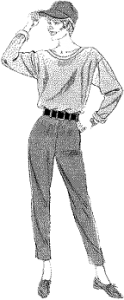Adapted from material by Vikki Jensen, Clothing and Make-up Technique Speaker/Consultant (604-467-7102)
Blouses
- sleeve seam should be even or slightly wider than your shoulders
- sleeves should come to wrist bone
- upper sleeves should allow for natural movement in all directions
- buttons must remain closed with no straining or pulling at buttonholes
- you should be able to pinch 2″ of fabric on each side of hip for proper blousing when tucked in
- if wearing as overblouse, there should be no pulling across hips, tummy or backside (should lie gently and easily across hips)
- should be no shorter than hipbone if tucking in
Jackets
- shoulder should be at least 1″ wider than your shoulders
- collar must lay flat and not wrinkle or pull across neck
- should be able to lie comfortably when buttoned over a blouse or sweater (even if you don’t intend to wear it this way)
- sleeve length should allow for 1/4″ blouse sleeve to show at wrist
- there must be absolutely no pulling across the back
- pockets must remain closed
- pleats or darts must lie flat
- should be enough room or ease for natural movement
Skirts
- pleats must lie flat
- there should be no pulling or creasing across front or back of hips, tummy or buttocks
- pockets on side must remain flat and closed
- straight skirts should hang straight down from buttocks (not curve under)
- should not “ride up” when you sit down
- kick pleats or slits should remain closed when standing
- waistband should allow for normal breathing
- thigh outlines must not show (can you turn the skirt around backwards easily?)
- panty lines must never show anywhere
Pants
- pleats, zippers, zipper openings must lie flat
- there should be no pulling or creasing across front or back of hips, tummy, buttocks or thighs
- must allow for natural movement (try this!)
- pant leg should hang straight down from the back of the buttocks (not curve under)
- side pockets should lie flat and closed
- waistband must allow for normal breathing
- panty lines must never show anywhere


